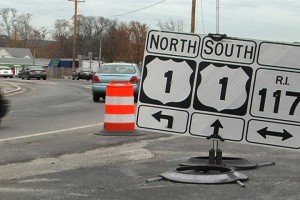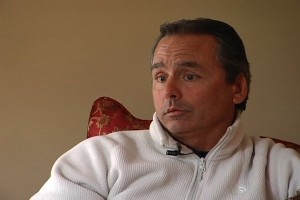 If you have to travel through Apponaug these days, you’re in for a challenge. For more than a year crews have been working on a $30 million project aimed at realigning what has traditionally been one of Rhode Island’s more difficult traffic patterns to navigate.
If you have to travel through Apponaug these days, you’re in for a challenge. For more than a year crews have been working on a $30 million project aimed at realigning what has traditionally been one of Rhode Island’s more difficult traffic patterns to navigate.
Robert Cote lives five minutes from the Apponaug Circulator and travels through it several times a day. For 25 years Cote has worked throughout New England in the construction industry as a quality assurance manager. While he specializes in high-rise buildings and structural steel, he also knows inside-out the Blue Book — Rhode Island DOT’s Standard Specifications for Road and Bridge Design.
 “The field conditions would suggest that clearly the code is not being followed,” said Cote, who first noticed a lack of dust mitigation at the beginning of the project, then the way crews were filling trenches that have been cut and refilled around the circulator.
“The field conditions would suggest that clearly the code is not being followed,” said Cote, who first noticed a lack of dust mitigation at the beginning of the project, then the way crews were filling trenches that have been cut and refilled around the circulator.
He questioned why, with two or three levels of oversight, that trenches have partially collapsed, causing dangerous driving conditions. Cote said he witnessed crews repeatedly doing so-called bucket strikes along this stretch of road leading into Apponaug.
“The bucket strike is a backhoe taking the end of the bucket and slamming it into the ground to try and flatten out the earth that is put back in the trench,” he said. “So on a regular basis I would see them performing bucket strikes with people from the Department of Transportation watching. It’s strictly prohibited by code. And the reason it’s prohibited by code is you can’t compact evenly. And what takes place after you cover that trench, you have uneven settling and the end result is that a road has dips and waves in it.”
So we took Cote’s concerns and video we shot of the circulator to Peter Alviti, who was appointed head of the Department of Transportation in February by Governor Gina Raimondo. Alviti acknowledged that on any given day, the Apponaug project has eight to 10 inspectors.
So what about what he saw in our video?
“From that video there were two areas — one in particular — over a gas trench where I saw about a 10-foot section that I would be concerned with. Our guys are going to be charged with going and taking a compaction test in that specific area. That does not meet our (specification). We will be out there testing that and it will be replaced if it doesn’t pass the test.”
As for the numerous trenches that have been cut and patched around the entire circulator, Alviti said they are only temporary and that the department will go back next year to re-excavate down a full 12 to 18 inches before a final coat of pavement is laid down at the end of the project.
Cote countered, “I want somebody to show me anywhere in the code where it allows for deviation from the code for a temporary fix. And, in fact, the code specifically states about utility trenches that have been cut, how they have to be finished and adjacent to the surrounding surface. There’s no allowance for a temporary surface. All temporary surfaces are supposed to be in the condition as if it was a finished, paved road.”
Alviti said he is working hard to change the way the D.O.T. fundamentally approaches road construction projects.
Jim Hummel (Motif): If you don’t do the right preparation, you may not see it in a year, two years, but long after the guys who are on the job are who knows where, then you’ve got problems with the roads. Who is accountable? I think that’s the question a lot of people have.
Peter Alviti: That’s a proper question to be asking and it’s one that we’re addressing here at D.O.T. We’re adding a dimension that’s never been here before by simply having every resident engineer that’s responsible for projects like this come in here every month and report on project status.
Cote says people have been making excuses for the condition of roads in Rhode Island for decades. “Everybody points the finger at everyone else and everyone blames the weather,” he said.
“And that’s what happens in New England. ‘Well we have bad winters, we have uplift, we have everything.’ Last I checked they get snow in Vermont, there’s weather in Vermont, there’s uplift in Vermont. But you don’t see roads in Vermont that look like roads in Rhode Island. And I think it’s a mentality that has happened for at least a generation if not more, that cutting corners is okay because at the end of the day we’re all going to get paid.”
The Hummel Report is a 501 3C non-profit organization that relies, in part, on your donations. If you have a story idea or want make a donation go to hummelreport.org, where you can also see the video version of this story. You can mail Jim directly at jim@hummelreport.org.


